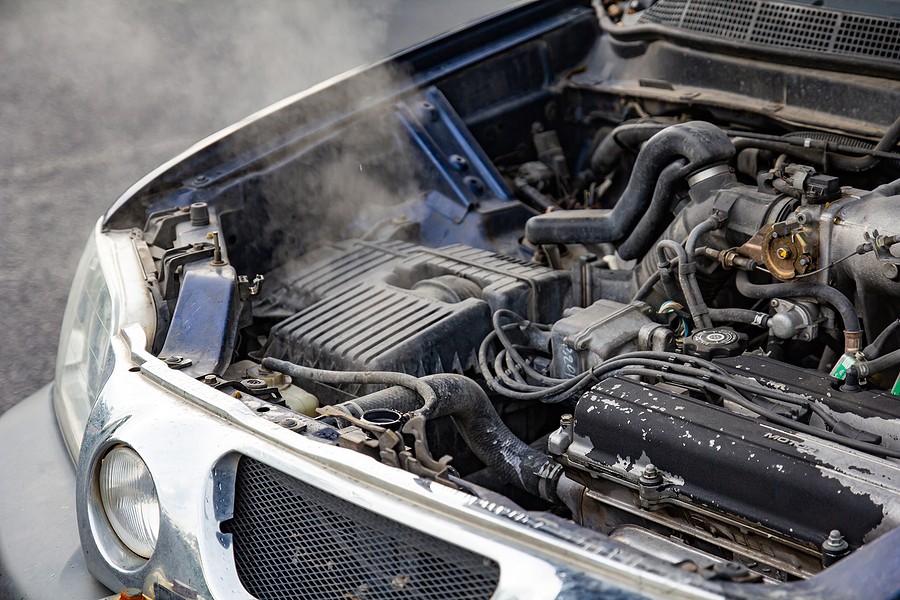The heater core in your vehicle is essentially a radiator that is used to help warm up the cabin of your vehicle on cool days. It takes the coolant that's used throughout the rest of your vehicle to cool down the engine and diverts it away from that system so that it can make more practical use of the heats that it takes away from your engine by allowing you to reap the benefits of it. It's an efficient system because otherwise the heat from your engine would just have essentially no purpose at all.
The way the heating and cooling system works in your vehicle is that as your engine warms up, coolant in the form of antifreeze circulates through the radiator where it is cools down, and then around the engine where it absorbs the heat before returning back to the radiator to cool down again. When everything is in proper working order, your car engine won't overheat.
On a cold day, when you want to turn the heat on in your vehicle, the heater cord diverts some of the coolant as it travels away from your engine and before it gets back to your radiator. The hot coolant goes through the core and a fan will blow the warm air that is produced as a result into your car's cabin. Since the coolant in your system can get up to about 200 degrees Fahrenheit, it's pretty efficient at keeping things toasty.
How Does a Heater Core Work?
As we said, the heater core diverts coolant away from the engine just briefly enough to make use of the heat before sending it back to the radiator where it will cool down again. A blend door inside your heater core allows the outside air to mix with the air from the heater core. That's what allows you to adjust the intensity of the heat in your car.
Signs of a Bad Heater Core
The heater core in your vehicle as we said it works like a small radiator. The fins inside the heater core are able to hold the heat that is absorbed from the heater tubes and then maximize the heat that can be transferred through the air blowing through the blend doors. When something goes wrong with your heater core there are some signs you could be able to look out for to let you know that you have a problem.
Window Film
This is a sign of a leak in your coolant system. If you have your heater on in an effort to defog your windows, you may notice what looks like fog building up on the window instead of dissipating. If you touch it it's not actually condensation formed by water but it will have a slimy feel because it's a fine mist of coolant that is built up, atomized by the heater blowing it through the vents on to your windshield. This can become very difficult to clean off and will significantly obscure your vision if it happens while you're driving. This is arguably the most dangerous problem associated with a bad heater core and if it happens you'll need to pull off the road as soon as you can and get your windshield cleaned off which can be a bit of a problem if you don't have a cleaning solution handy.
The second problem with this happening is that, since it indicates a leak in the coolant of your vehicle, you're also at risk of your engine overheating. If it is a new leak or a small leak you will hopefully be able to catch it in time and get it repaired. If it's allowed to go on for too long however then you risk your engine overheating and some serious damage down the road that could get you paying some significant repair bills at your next mechanic visit.
Visible Coolant Leak
In addition to the coolant just getting vaporized and spraying up on your windshield when you use the defogger, you may also notice coolant leaking into the cabin of your vehicle. If the leak has happened in the heater core itself, which is located behind the dashboard of your car, it may run out from behind the panels of your dashboard. Often, you'll see this running down the inner walls of the centre console down by your feet or the feet on the passenger side of the vehicle. It will leak out through the vents that normally provide the hot air when the heater is working, and you try to warm up your feet while driving.
Sweet Smell
Antifreeze has a noticeably sweet smell to it. It's actually very appealing to many animals who will drink it if they get the chance, which is one of the reasons you need to be so careful with antifreeze leaks and how it's stored. If you notice the smell in the cabin of your vehicle and clearly you have an antifreeze leak somewhere and the heater core is the most likely cause since you can smell it when you're behind the wheel. If the smell becomes more noticeable when you turn the heater on while the fan is blowing, then you can very likely safely bet that it is a coolant leak coming from the heater core itself that needs to be addressed.
As we said, animals are very attracted to the smell of coolant but it's also highly toxic. Because the smell is so appealing, it's also a risk for young children as well who might think it's something that they want to taste. Antifreeze poisoning can occur after having ingested fairly low quantities of the substance. If this happens, you'll need to get medical attention as soon as possible for either the animal or the person who ingested it.
No Heat
The most obvious problem with a bad heater core is that the heat in your car simply doesn't work anymore. If you find that when you turn the heat on even after the engine has been running for a while and nothing is happening, then that's a good sign your heater core has failed. This can be the result of any number of potential problems from a leak in your coolant system to a buildup of sediment that gets clogged in the heater core. If your heater core is clogged, then a heater core flush may work as a solution to this problem.
What is a Heater Core Flush?
When the heat isn't working at all in your vehicle and you don't have a coolant leak, it's possible that a heater core flush will fix the problem for you. As the name implies, a heater core flush flushes the heater core system to remove the debris or clogs that may have formed in it which are preventing it from heating up your vehicle properly. Generally, this is done by forcing compressed air and water through the system in an effort to force the clogs and get everything running properly again.
If you head to a mechanic, you can probably get a heater core flush done for somewhere between $100 and $150. That said, the process of doing a heater core flush is not terribly complex in and of itself and if you are comfortable doing repairs on your vehicle you may want to try this one on your own. It's not exactly a basic repair on par with changing a tire or replacing an oil filter, but it is not as complex as trying to replace a timing chain or swapping out an exhaust manifold either. If you feel up to the task, the process is fairly straightforward and only requires a minimum amount of materials.
How to Perform a Heater Core Flush at Home
There are a handful of tools that you'll need if you want to perform a heater core flush on your own. gather these ahead of time so that you'll be prepared to get the job done.
- An air compressor
- A 3/4-inch barbed fitting adapter
- Pliers or a screwdriver as necessary to remove clamps that are holding hoses in place
- Clean plastic tubing
- Safety glasses, gloves and regs
- A bucket large enough to collect the coolant that comes from lines
- Your garden hose
There are a handful of steps to follow to flush out your heater core. If any step seems unclear, then you can refer to any number of videos you'll find on YouTube that can walk you through the process just show you in real-time just what you need to be doing. That said, it shouldn't be too difficult to follow along.
- Under the hood of your car locate the firewall that separates the engine from the interior of your vehicle and find the two thick hoses that are running out of it. These are the coolant lines that we are going to flush. One takes coolant in; one draws coolant out.
- Make sure your bucket is in place to catch any runoff and unclamp the hoses from the firewall. if they're stuck too firmly in place you may need to give them a spritz of WD-40 to get the moving properly.
- Once the hoses have been released you can attach the air compressor to the outlet hose. Some kind of coupler will be needed to make sure the attachment is secure or, if you're doing this very DIY you can use some duct tape. You don't want your pressure to go above 20 psi here and there's no need to run it for more than 10 minutes to force out everything that may be in the line. Any more time or any more pressure and you may damage the heater core. Remove the air compressor when you're done.
- Use the three quarter-inch adapter to attach the tubing to the garden hose at the outlet. Remember that you don't want the pressure to get too high here, but your garden hose likely doesn't have a pressure gauge. At full blast your garden hose probably pushes water at 40 psi. You want to keep it between 10 and 20 psi so make sure it's not going as powerfully as it can. Let the water filter through until it runs clear into the bucket.
- You can repeat this process a second time with the inlet hose.
- Detach the hose and then reattach the air compressor. This will blow out any excess water in the line.
- You can use a radiator cleaner to flush the system at this point as well. You can buy good quality radiator cleaners for about $15 or so on Amazon.com
- If you opt to use a radiator cleaner, you want to rinse everything with water again to get the radiator flush cleared out.
- At this point you can reattach the hoses, and re-secure the clamps in place. If there is any spilled coolant make sure you get it cleaned up from the engine parts as well as from under your vehicle. Pay extra attention to the belts because they can get slippery if they're covered in antifreeze and may come loose.
- You'll need to top up the coolant in your system now with that 50/50 mix of antifreeze and water.
- You can now start your car and let it run until the coolant circulates through the system. You'll also be able to test the heater core once it gets up to temperature to make sure everything's working the way it's supposed to.
- If the problem was a clog in your heater core that required a flush, everything should be working as normal now. If you're still having a problem with your heater then the flush was not getting to the root of the problem and you may need to go to a mechanic to get the problem properly diagnosed.
The Bottom Line
If you’ve ever had to drive somewhere on a cold winter morning when the heat wasn't working you realize just how important the heater core is. Getting a new heater core in your vehicle could cost between $500 and $1,000 if it needs to be completely replaced. Hopefully the flush is all that will be required to get it working for you again if you're having a problem with it. As you can see it's a much cheaper option and will likely save you some time and frustration as well as money in the long run.



